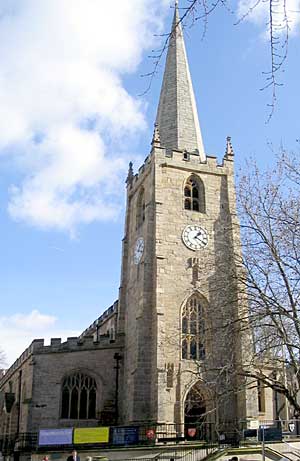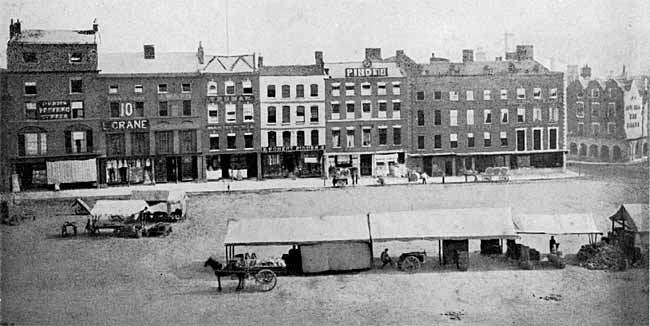< Previous | Contents | Next >
St Peter's Church and South Parade

St Peter's Church (A Nicholson, 2004).
The thoroughfare through the lower stages of the tower is closed by a vault and the tower itself is 160 feet above St. Peter's Square, that is to say, 30 feet higher than is the castle platform above Castle Boulevard. The tower contains eight bells which are extremely tuneable and which are well known to campanologists. They were all recast in 1771 and the most interesting of them is the seventh bell which was given in 1543 by Margaret Doubleday, a washerwoman, together with a legacy of 20/- per annum for the sexton of St. Peter's to ring this bell at four o'clock each morning. Originally the spire was crocketed, but the crockets were sawn off in 1825. The vane was placed upon the summit in 1789 by a man called Wootton, who at that time rebuilt the upper four yards of the spire and ever since that time the spire has been very troublesome to the Church authorities. It was repaired in 1825 when, unfortunately, Mansfield stone was used which has always remained light in colour and has given the spire a very patchy look. In 1841 it was again repaired, and, finally, some modern and satisfactory reparations took place in 1914 and 1915 from which repairs we may hope that long life and less trouble will ensue to this landmark. The expense of keeping the clock in order is borne by the town, for St. Peter's clock is of considerable public utility. The organ was placed in the church in 1811, but there must have been an older organ for the case is Jacobean and is quite good, while the chamber in which the organ at present stands succeeds to the site of the burial vault of the great Smith family.
But in spite of all its deficiency the interior of St. Peter's Church is extremely picturesque, particularly so on a sunny Sunday morning when the children of the Bluecoat School in their quaint dresses attend service and this picturesqueness is much enhanced by the associations which St. Peter's has with the past, for many events of interest have taken place in and about the church. For example in 1794 a man called Isaac Rooke was found apparently dead in a close near Nottingham. He was prepared for burial and taken to St. Peter's Church where his body was left for a few hours during which time he revived and one can imagine what his feelings must have been. Then we have the fact that in 1660 Huntingdon Shaw, the great iron worker who was associated with Tigau in his great artistic achievements was brought as an infant to this church to be baptised, but the most stirring story about the church and the one which brings home to one the continuity of ancient life more than any other is the story of Henry Steeping. In 1515 Henry Steeping came rushing down Wheeler Gate and took sanctuary in St. Peter's Church confessing that he had attempted to murder Thomas Mellors, Mayor of Nottingham. Mellors was peacefully drinking and conversing with the Abbot of Dale, the Prior of Lenton and others in Alderman Williamson's house when Steeping walked into the room and without more ado produced a dagger and stabbed him. Of course when Steeping got into the church he was safe and it is a very interesting reflection to realise that by stepping aside a few yards from the turmoil and bustle of modern traffic we may recapture something of the peace and safety which extended even to those wretched criminals of the 16th century.
SOUTH PARADE.

South Parade in the 1870s.
Returning now to the Market Place and continuing our perambulation we pass along South Parade which in 1407 was called Timber Hill because as we have seen, timber was stored and sold under the row of seven great elm trees which ran parallel to it. In 1795 this name appears to have been abandoned and the row was called "The Market Place," South Parade being a modern name.
There are two interesting sites in this row the first being number 12, for the modern shop stands upon the site of Dunn's book shop which was a very well known rendezvous for all interested in literature and culture a century ago. In addition to being a bookseller Mr. Dunn was a patron and friend of all literary men. It was in his rooms that Philip James Bailey read "Festus" aloud before publication and we know that Wordsworth was here upon one occasion, while Montgomery was not an infrequent visitor. The name of Bailey and Wordsworth are household words, but Montgomery's name is not so well known, although certain of his poems are very much more frequently quoted than is generally supposed. He was born in 1771 and died in 1854. Son of a Moravian Pastor, his poems have been described as "bland and deeply religious" and nobody dreams of reading them nowadays, but his hymns have come down into general use. "Angels from the Realms of Glory," "Go to dark Gethsemane," "For ever with the Lord," and "Hail to the Lord's Anointed," together with others of his writing are frequently sung by congregations nowadays.
Next door to Dunn's book shop stood a fine house which was one of three traditionally supposed to have been built by Marshal Tallard about 1704. It was a fine old house and displayed the twisted columns which were a feature of the architecture of his day, but it was pulled down to make room for the really impressive block of buildings that now houses the National Provincial Bank which was originally erected for the great banking house of Smith whose origin we have just seen.
